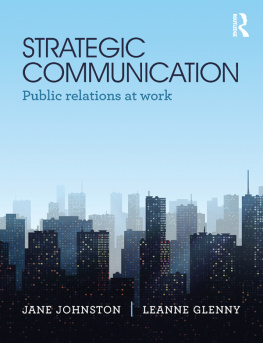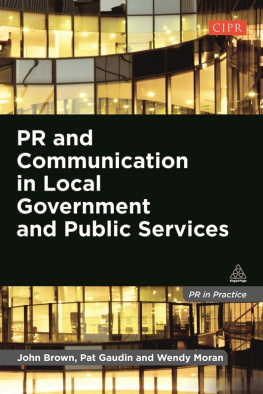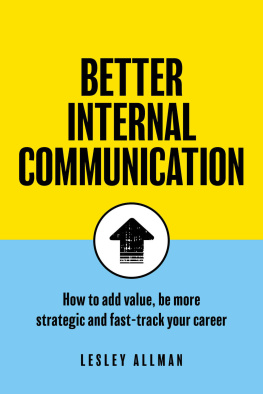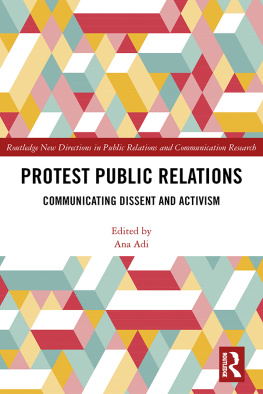First published 2021
by Routledge
2 Park Square, Milton Park, Abingdon, Oxon OX14 4RN
and by Routledge
52 Vanderbilt Avenue, New York, NY 10017
Routledge is an imprint of the Taylor & Francis Group, an informa business
2021 Jane Johnston and Leanne Glenny
The right of Jane Johnston and Leanne Glenny to be identified as authors of this work has been asserted by them in accordance with sections 77 and 78 of the Copyright, Designs and Patents Act 1988.
All rights reserved. No part of this book may be reprinted or reproduced or utilised in any form or by any electronic, mechanical, or other means, now known or hereafter invented, including photocopying and recording, or in any information storage or retrieval system, without permission in writing from the publishers.
Trademark notice: Product or corporate names may be trademarks or registered trademarks, and are used only for identification and explanation without intent to infringe.
British Library Cataloguing-in-Publication Data
A catalogue record for this book is available from the British Library
A catalogue record for this
book is available from the
National Library of Australia
ISBN: 978-0-367-64108-5 (hbk)
ISBN: 978-1-760-87643-2 (pbk)
ISBN: 978-1-003-12193-0 (ebk)
Set in 11/15 pt Janson Text LT by Midland Typesetters, Australia
Contents
Overview
Part 1: Foundations and the working environment
Introducing strategic communication and public relations
Communication at work
Issues, risk, crises and corporate social responsibility
Ethical and legal practice
Working in a media-dominated world
Part 2: Process, planning and implementation
Research, measurement and evaluation
Working strategically
Planning and campaign development
Tactic selection and content creation
Part 3: Theory
Theory: Where learning starts
Index
Working through this book
This book comprises ten chapters. It is delivered in three parts. Part 1: Foundations and the working environment is intended to provide a clear context for strategic communication and public relations; Part 2: Process, planning and implementation presents the procedural approach for making things happen; and Part 3: Theory presents a summary of a diverse range of more than 30 theories, complete with examples and cross-referenced throughout the book.
Part 1: Foundations and the working environment
Chapter 1: Introducing strategic communication and public relations
What is strategic communication? What is public relations? This chapter responds to these questions by providing clear definitions plus an overview of these dynamic and changing fields and the nine chapters that follow. It introduces you to the tools used to navigate the booksticky notes, fact checks and quick tipsused as sign posts throughout. It presents brief descriptions of taken-for-granted words and concepts (e.g. publics and communication) and provides a succinct table of the roles in strategic communication and PRfrom brand management to storytelling. The chapter provides a brief overview of the growing field as it developed in Australia and New Zealand in industry and education. Finally, it presents a list of the core capabilities of the growing profession developed by the Global Alliance for Public Relations and Communication Management.
Chapter 2: Communication at work
This chapter provides an overview of the main contexts for communication and PR practice, covering three broad sectors: government (public sector), corporations (private sector) and charities (not-for-profit or NFP sector). These three sectors represent just about every field you might find yourself working in across politics, government, corporate and finance, community work, activism, financial relations, consumer advocacy, industrial lobbying and corporate partnerships. The chapter introduces you to a range of terms that are relevant to these sectors: non-government organisations or NGOs, community action groups or CAGs, not-for-profits and others. It overviews the communication and PR role as centrally located in all of these, illustrating the breadth and scope that these fields cover. Finally, it sets the foundation for the following chapters, which, in turn, examine and explore the fundamental elements of strategic communication and PR.
Chapter 3: Issues, risk, crises and corporate social responsibility
This chapter overviews the four equally important and connected fields of issues, risk and crisis communication and corporate social responsibility (CSR). First, it explores the issues management role in the routine monitoring of issues affecting the day-to-day operations of an organisation and how it provides the warning signs of low-level problems. Issues management includes scanning the environment, identifying hazards, problem-solving and understanding what your stakeholders want and what you can deliver. Risk and crisis communication are also associated with issues management, and the chapter explores how the three concepts are both connected and distinct. It explains how to identify and manage risks and crises and discusses crisis recovery. Finally, the chapter links these areas to the important field of CSR and how corporations need to consider their impact on society, the environment and their investors.
Chapter 4: Ethical and legal practice
Following on from CSR, this chapter begins by looking at the related issue of ethics, before considering the regulatory and legal environment. It explains the philosophical issues behind common ethical challenges faced by the communication professions, such as duty and loyalty, persuasion, truth and authenticity, recognising that these foundations apply equally in the contemporary online environment. This is followed by a more focused examination of codes of ethics/conduct and includes some ethics-based tools such as the Potter Box, the decision-making guide promoted by the Global Alliance for PR and Communication Management, and other resources. Common legal issues for communication practitioners working in the on- and offline space are discussed, including copyright, defamation, contracts and consumer law.
Chapter 5: Working in a media-dominated world
We live in a media-dominated world. This chapter looks at the digital media environment and the massive role it plays in strategic communication and PR, and society more broadly. It uses theory and practical examples to examine industries, media platforms and multi- and trans-media use in professional communication. The chapter unpacks the role of the popular media model PESO (paid, earned, shared and owned) and how it exemplifies the converged world of media. It includes a look at that amazing modern invention the smartphone, and how it has been a game-changer in life as well as industry. The chapter explores the importance of media literacy, the role of journalists and influencers and includes an overview of three basic media tools: media releases, press conferences and social media content planners. The chapter concludes with a look at some of the power issues that emerge in the pervasive media environment including news aggregation, data breaches and the loss of privacy.












